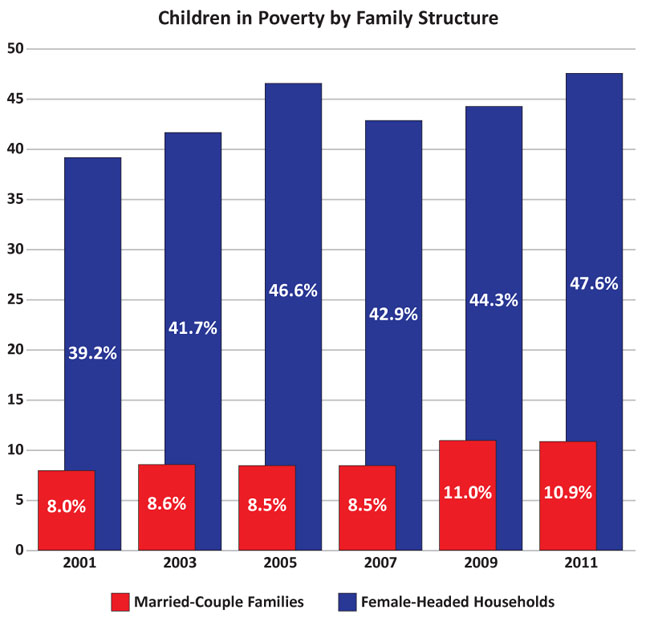Some fathering advocates would say that almost every social ill faced by America’s children is related to fatherlessness. Six are noted here. (Also see related fatherlessness epidemic infographic)
As supported by the data below, children from fatherless homes are more likely to be poor, become involved in drug and alcohol abuse, drop out of school, and suffer from health and emotional problems. Boys are more likely to become involved in crime, and girls are more likely to become pregnant as teens.
1. Poverty
– Children in father-absent homes are almost four times more likely to be poor. In 2011, 12 percent of children in married-couple families were living in poverty, compared to 44 percent of children in mother-only families.
Source: U.S. Census Bureau, Children’s Living Arrangements and Characteristics: March 2011, Table C8. Washington D.C.: 2011.
– Children living in female-headed families with no spouse present had a poverty rate of 47.6 percent, over 4 times the rate in married-couple families.
Source: U.S. Department of Health and Human Services; ASEP Issue Brief: Information on Poverty and Income Statistics. September 12, 2012 http://aspe.hhs.gov/hsp/12/PovertyAndIncomeEst/ib.shtml
Source: U.S. Department of Health and Human Services; ASEP Issue Brief: Information on Poverty and Income Statistics. September 12, 2012 http://aspe.hhs.gov/hsp/12/PovertyAndIncomeEst/ib.shtml
– The U.S. Department of Health and Human Services states, “Fatherless children are at a dramatically greater risk of drug and alcohol abuse.”
Source: U.S. Department of Health and Human Services. National Center for Health Statistics. Survey on Child Health. Washington, DC, 1993.
Source: Hoffmann, John P. “The Community Context of Family Structure and Adolescent Drug Use.” Journal of Marriage and Family 64 (May 2002): 314-330.
– A study of 1,977 children age 3 and older living with a residential father or father figure found that children living with married biological parents had significantly fewer externalizing and internalizing behavioral problems than children living with at least one non-biological parent.
Source: Hofferth, S. L. (2006). Residential father family type and child well-being: investment versus selection. Demography, 43, 53-78.
Sources: The Lancet, Jan. 25, 2003 • Gunilla Ringbäck Weitoft, MD, Centre for Epidemiology, the National Board of Health and Welfare, Stockholm, Sweden • Irwin Sandler, PhD, professor of psychology and director of the Prevention Research Center, Arizona State University, Tempe • Douglas G. Jacobs, MD, associate clinical professor of psychiatry, Harvard Medical School; and founder and director, The National Depression Screening Program • Madelyn Gould, PhD, MPH, professor of child psychiatry and public health, College of Physicians and Surgeons, Columbia University; and research scientist, New York State Psychiatric Institute.
http://www.webmd.com/baby/news/20030123/absent-parent-doubles-child-suicide-risk
Source: Osborne, C., & McLanahan, S. (2007). Partnership instability and child well-being. Journal of Marriage and Family, 69, 1065-1083.
– Children in grades 7-12 who have lived with at least one biological parent, youth that experienced divorce, separation, or nonunion birth reported lower grade point averages than those who have always lived with both biological parents.
– Children living with their married biological father tested at a significantly higher level than those living with a nonbiological father.
Source: Osborne, C., & McLanahan, S. (2007). Partnership instability and child well-being. Journal of Marriage and Family, 69, 1065-1083.
– Father involvement in schools is associated with the higher likelihood of a student getting mostly A’s. This was true for fathers in biological parent families, for stepfathers, and for fathers heading single-parent families.
Source: Nord, Christine Winquist, and Jerry West. Fathers’ and Mothers’ Involvement in Their Children’s Schools by Family Type and Resident Status. (NCES 2001-032). Washington, D.C.: U.S. Department of Education, National Center for Education Statistics, 2001.
– 71% of high school dropouts are fatherless; fatherless children have more trouble academically, scoring poorly on tests of reading, mathematics, and thinking skills; children from father-absent homes are more likely to be truant from school, more likely to be excluded from school, more likely to leave school at age 16, and less likely to attain academic and professional qualifications in adulthood.
Source: Edward Kruk, Ph.D., “The Vital Importance of Paternal Presence in Children’s Lives.” May 23, 2012.
http://www.psychologytoday.com/blog/co-parenting-after-divorce/201205/father-absence-father-deficit-father-hunger
5. Crime
– Adolescents living in intact families are less likely to engage in delinquency than their peers living in non-intact families. Compared to peers in intact families, adolescents in single-parent families and stepfamilies were more likely to engage in delinquency. This relationship appeared to be operating through differences in family processes—parental involvement, supervision, monitoring, and parentchild closeness—between intact and non-intact families.
Source: Stephen Demuth and Susan L. Brown, “Family Structure, Family Processes, and Adolescent Delinquency: The Significance of Parental Absence Versus Parental Gender,” Journal of Research in Crime and Delinquency 41, No. 1 (February 2004): 58-81.
http://familyfacts.org/briefs/26/marriage-and-family-as-deterrents-from-delinquency-violence-and-crime
Source: Knoester, C., & Hayne, D.A. (2005). “Community context, social integration into family, and youth violence.” Journal of Marriage and Family 67, 767-780.
Source: Heather A. Turner, “The Effect of Lifetime Victimization on the Mental Health of Children and Adolescents,” Social Science & Medicine, Vol. 62, No. 1, (January 2006), pp. 13-27.
Source: Bush, Connee, Ronald L. Mullis, and Ann K. Mullis. “Differences in Empathy Between Offender and Nonoffender Youth.” Journal of Youth and Adolescence 29 (August 2000): 467-478.
6. Sexual Activity and Teen Pregnancy
– A study using a sample of 1409 rural southern adolescents (851 females and 558 males) aged 11 – 18 years, investigated the correlation between father absence and self-reported sexual activity. The results revealed that adolescents in father-absence homes were more likely to report being sexually active compared to adolescents living with their fathers.
Source: Hendricks, C.S., Cesario, S.K., Murdaugh, C., Gibbons, M.E., Servonsky, E.J., Bobadilla, R.V., Hendricks, D.L., Spencer-Morgan, B., & Tavakoli, A. (2005).
Source: Teachman, Jay D. “The Childhood Living Arrangements of Children and the Characteristics of Their Marriages.” Journal of Family Issues 25 (January 2004): 86-111.
You can be a part of the solution!
Learn how to Get Involved, and if you’d like to support us financially, please donate today.

